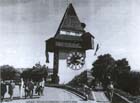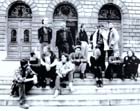A dynamic and
challenging task for universities
Austria's participation in the ERASMUS
programme since 1992 may have meant that universities have had to take
new responsibilities, but is has also given them new opportunities. 1999
marks nine years of ERASMUS and the beginning of the SOCRATES II programme;
having gathered a variety of experience in several different functions,
I am in a position to draw up the following balance of accounts.
How it all began
As Austria was due to join the ERASMUS
programme in the academic year 1992/1993, I was invited to present the
Technical University Graz at a network meeting at Hannover University.
This led to our participation in an established network of European Architectural
Colleges which was coordinated by Martin Andersch at the Ecole d' Architecture
de Languedoc-Roussillon in Montpellier and included 32 institutions from
all over Europe.
In 1993 we joined a network coordinated
by the University of Bath comprising 14 participating universities. From
one moment to the next, we were able to take up contact with all of the
countries in Europe. An essential precondition for succesfull entry in
these established networks was the absolute and unreserved support and
backing of our own Department for International Academic Relations, created
in 1990 as part of the central administration.
In the first year, student mobility at
the Faculty of Architecture was limited to outgoing exchanges; there were
as yet no incoming students for the department to welcome. The first incoming
students arrived in the second year, partly thanks to the outgoing students
of the first year, who had performed their role as "ambassadors" brilliantly
alongside their studies and had introduced partner universities to their
home university.
As well as student mobility, Montpellier
proposed an intensive programme with a workshop and design seminar to be
held annually at one of the network institutions in conjunction with a
coordinator's meeting.
Active participation in network meetings
over the following years led to a continual increase in student mobility.
The results of the seminar were evaluated and discussed at the coordinator's
annual meetings. This also gave all the participants the opportunity to
get to know the various teaching models and special features of the partner
institutions and to take these into consideration when organising student
exchanges. The figures speak for themselves: the Faculty of Architecture
at the Technical University Graz achieved a mobility rate of 46 incoming
and 40 outgoing students in the academic year 1998/1999.
Gaining Experience
My participation in coordinators' meetings
and intensive programmes (at Hannover University in 1991, the South Bank
University, London in 1992, the "Institut Superieur d'Architecture de I'Etat-La
Cambre" in Brussels in 1993 and at the "Universita degli Studi di Bari"
in 1994) enabled me to gain the necessary experience to organise an intensive
programme and coordinators' meeting in Graz in 1995.
In 1996, we were joined by Lyon and the
cooperation of the "Ecole d'Architecture de St. Etienne" in 1997, the network's
last intensive programme and coordinators' meeting was held in Montpellier;
as guest professor, I was present as a coorganiser.
It was decided at this coordinators' meeting
that the intensive programmes would continue to be organised annually by
the participating colleagues, which would finance them with their own means.
This decision grew out of our conviction that the intensive programme did
not only offer participating students a valuable addition to their studies,
but was also the source of a wide range of international experiences for
the participating university teachers. The 1998 meeting was organised by
Malmö and the University of Lund. The coordinators' meeting provided
a crucial foundation for the continuing expansion and consolidation of
relations between the universities.
Teaching in an European dimension
Teaching staff mobility and direct inclusion
in the existing curriculum was begun in the academic year 1997/1998, the
year in which the network became part of an institutional contact. I was
involved in teaching design and monument maintenance at the "Ecoles d'Architecture
in Montpellier and Paris - Belleville (in French) and at the University
of Lund (in English). Colleagues from these partner institutions were integrated
into my teaching activities in Graz.
A t the "Conference on Architectural Education
in Europe" in June 1996 in Mantova, in which numerous coordinators took
part, the various national teaching systems were discussed. Fundamental
principles were elaborated by each working group of national representatives
and published in "The National Systems of Higher Architectural Education
in Europe" (1997, Edizione Unicopli, Milan). As all architecture schools
in Europe face a teaching reform in which the main issues almost everywhere
will be the number of students, the length of studies, the image of an
architectural qualification and the high level of unemployment in the architectural
profession, these things have begun to play a part in teaching staff mobility
programmes. Colleagues from Sweden and France who have visited Graz Technical
University have spoken to the curricular committee as well as joining in
our teaching activities, and have made valuable contributions to the discussion
on curricular reforms which will have to take place according to the new
University Studies Act.
ECTS at the Technical University Graz
One of the very positive aspects of Graz
Technical University's international policy has been the introduction of
the ECTS (European Credit Transfer System) for all faculties following
the conclusion of the pilot project phase in Mechanical Engineering. The
official recognition of students' achievements can be carried out without
any problems and Graz Technical University has been able to play a leading
role in this as regards its partner institutions.
When ERASMUS students work on their diploma
thesis at partner institutions, the supervising teachers are invited to
Graz as examiners at diploma examination, This involves mobility beyond
the terms of the institutional contract, and gives our foreign colleagues
the opportunity to spend a short time gaining an insight into the internal
affairs of Graz Technical University. An European dimension is brought
to the topics examined in the diploma thesis as well as to the examination
itself, As a member of examining boards in Paris and Strasbourg, I was
able. to draw comparisons with Graz and to familiarise myself with different
examining systems.
Vital Impulses
Our many years of intensive cooperation
mean that friendships have developed as well as official contacts, enabling
us to put our activities into practice in an unbureaucratic and efficient
way. The bilateral contacts within the institutional contract form the
basis for necessary annual evaluation exercises. The success of planned
activities can be examined in practice together with the individual partner
university. The bilateral contracts which we have signed with Prague, Budapest
and Maribor are the continuation of an as yet invisible network and further
contracts are currently being prepared.
The European Union's programmes give vital
impulses, but ideas are put into practice partly by the heads of each participating
institution and mainly by the work of a few committed individuals. Selfsatisfaction
and laziness are the greatest obstacles in the way of the construction
of the necessary broader basis for further development in established university
exchange relationships once the pioneer phase is over. |












|